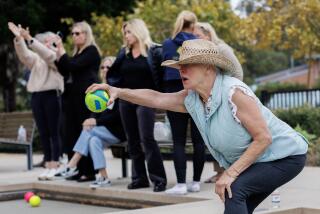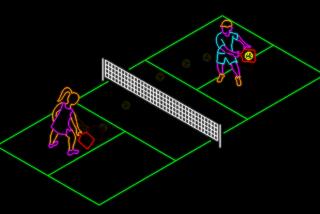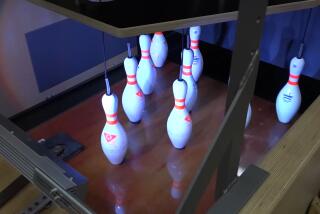Arcade Game Is on a Roll : This kitschy pastime has survived a generation of high-tech video playgrounds by making money.
- Share via
For just 3 points, you can get a fake bug; for 6, a plastic comb. Gather 60 points, and a paddle ball can be yours.
From there, the stakes climb. A plastic bowling set is 400 points. Got your eye on the radio-controlled car? Save up 2,000 points. And for you trend-conscious players, an electric espresso maker. Take it home for just 7,000 points.
Amid the electronic din of video games and modern pinball machines, Skee Ball is a reassuringly unglamorous throwback to the skill games of old, its anachronistic air only enhanced by the carnival touch of winning prizes.
The concept is simple enough: Roll a wooden ball down a short alley, over a ramp and into a target. The top bull’s-eye scores 50 points, while the outside ring scores 10. Missing the target altogether is a big 0. Generally, the tab for all this excitement is nine balls for a quarter.
Skee Ball was patented in 1909, but in those days the alleys were 36 feet long and the game was “only played by men,” according to Mary Cox of Skee Ball Inc. in Chalfont, Pa. The alley was shortened to 14 feet in 1928; these days, most are 10 or 13 feet long.
While the popularity of video games can rise and fall at a dizzying rate, the Skee Ball business, said Cox, has “been pretty steady for years.”
Skee Ball can be played at several places around the county, but probably the biggest concentration of machines is at the Balboa Fun Zone, with next-door neighbors Bay and Playland arcades offering Skee Ball and prizes (the nearby Odyssey has the game, but no prizes).
Bill Hudson of the Bay Arcade said the game gets mostly casual players, although there are a few serious locals who save up their tickets for the big prizes. Such items as portable barbecues and boomboxes are not just for show, he said. They are given away from time to time.
“There is some skill involved. One guy who comes in gets a perfect score once in a while,” Hudson said. That’s 450 points, a score of 50 on each ball.
At the Bay Arcade a perfect score rates 30 tickets, each worth 3 points, but the winnings drop dramatically from there. Getting 400 points or more is worth 10 tickets, a score of 270 rates four tickets. Players need to score at least 150 to earn a ticket.
So, that means a player who averaged a healthy 270 points a game would be paying about $146 for an espresso maker, $42 for the radio-controlled car. As the skill level drops, the price soars.
Of course, most players aren’t as serious as all that. According to Hudson, during the day on weekends, many of the players are parents with their small children. After dark, the crowd around the Skee Ball alleys is largely college-age.
“You get all ages,” said Hudson--all except, for the most part, teens. Most kids outgrow Skee Ball at about age 13, turning to video games. After high school, though, some teens return to the game, lured by the rediscovery of its kitschy, low-tech appeal.
Although the basic game hasn’t changed much over the years, the machines at the Bay do boast electronic scoreboards. Next door at Playland, however, the machines still display the score with metal flip cards.
How do Skee Ball, and such related skill games as Pokereno, survive a generation into the high-tech era of video games? The old-fashioned way--by making money.
“It’s always been one of our best moneymakers,” Hudson said. “That’s why we take up so much space with them.”
Bay Arcade is at 706 E. Bay Ave. in Newport Beach’s Balboa Fun Zone. For information, call (714) 673-0324. Playland Arcade is at 703 Edgewater Ave.; call (714) 673-7740 for information.
More to Read
The biggest entertainment stories
Get our big stories about Hollywood, film, television, music, arts, culture and more right in your inbox as soon as they publish.
You may occasionally receive promotional content from the Los Angeles Times.










